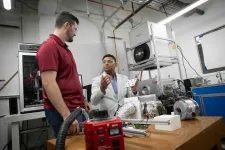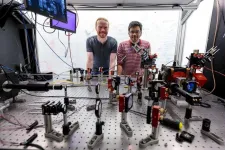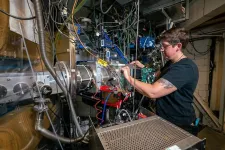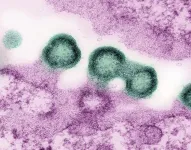(Press-News.org) New guidance on peri-operative care of transgender and gender-diverse individuals is today published in Anaesthesia (the journal of the Association of Anaesthetists) to guide best practice to ensure the safety and dignity of transgender and gender-diverse people in the peri-operative period. The guidance has been produced by a working group of experts including Dr Stuart Edwardson, Royal Infirmary of Edinburgh, Edinburgh, UK, and Dr Luke Flower, Victor Philip Dahdaleh Heart and Lung Research Institute, Cambridge, UK, and colleagues.
The number of people openly identifying as transgender and/or gender diverse has increased significantly over the past decade, most likely as a result of emerging clarity and comfort with open expression. Census estimates from 2021 identified 262,000 people living in the UK identifying with a gender that does not correspond with that assigned at birth. It is worth noting that this is a lower estimate than others, most likely due to hesitation of people to disclose.
Around 50% of transgender and gender-diverse people are currently undergoing some form of medical treatment for gender affirmation (whether this is hormonal therapy, surgical affirmation or both), and a further 25% are not currently accessing gender-affirming medical interventions but wish to. Many aspects of these interventions provide specific and important considerations for
the anaesthetist in the peri-operative period.
The authors say: “Transgender and gender-diverse people comprise a significant and varied minority with specific healthcare needs that are often both poorly misunderstood and met. It is our collective responsibility for this inequity to be addressed. Transgender and gender-diverse people, in addition to some specific needs, experience the same health problems as everyone else and will therefore present to all services whether specialist or not. This guideline sets out a structured explanation of current evidence and practicalities to be considered for any anaesthetist looking after a transgender and gender-diverse patient in any scenario or area of the hospital.”
They add that the new guidance is necessary as there is currently no existing guidance covering the scope and focus of this document.
The working group make some key recommendations:
The patient’s preferred name and pronouns should be confirmed and used at all times. This is an important way of showing respect and decreasing the risk of gender dysphoria.
There should be a process in place whereby a patient can privately and safely disclose both their sex at birth and gender as part of pre-operative assessment. Digital pre-assessment questionnaires can provide this in an elective setting.
All forms of social, medical and surgical gender affirmation should be identified at pre-operative assessment, and sensitive explanations given to the patient for the purposes of enquiring. Anaesthetists should be aware that many aspects of gender-affirming care may not be present on a patient’s health record (including gender-affirming surgical procedures).
A pre-operative pregnancy test should be offered to all patients who have a uterus and ovarian tissue between the ages of 12 and 55 years, regardless of the use of contraception.
All specific peri-operative considerations for transgender and gender-diverse patients, including name and pronouns, should be communicated with the team at the surgical brief. Transgender status need only be shared with the patient’s consent and if it is deemed important for the safety of their care. It should be given the same level of confidentiality as any other sensitive personal information.
Chest binders should ideally be removed, with the patient’s consent, before anaesthetic intervention.
Hormone therapy should be continued throughout the peri-operative period unless there are specific contraindications. Patients should be counselled on the risks and benefits of this with the aim of making a shared decision.
Transgender and gender-diverse patients should be cared for in an environment that respects their gender identity. In some circumstances, this may involve providing a single room.
Organisations should have clear guidance for the care of patients who are transgender and gender-diverse. This should include specific educational materials to increase awareness of issues impacting their access to high-quality care.
All areas of peri-operative and perinatal practice should embrace gender-inclusive language to honour all identities.
Pregnant patients who are transgender or gender diverse should be seen in an anaesthetic clinic in the antenatal period to inform and support decision-making and plan care before presenting in labour.
The authors conclude: “The objective of this document is to guide best practice to ensure the safety and dignity of transgender and gender-diverse people in the peri-operative period. While they may have specific health needs in relation to gender dysphoria, their health requirements go beyond their gender identity. Most doctors will provide care to someone who is transgender or gender-diverse at some stage in their career. It is therefore important that all anaesthetists are educated on specific considerations when caring for these patients.”
“This document provides the first guidance produced to advise on best practice to ensure the safety and dignity of trans and gender-diverse individuals in the peri-operative period.”
Dr Stuart Edwardson, Royal Infirmary of Edinburgh, Edinburgh, UK. Please e-mail with interview requests. E) stuart.edwardson@nhs.scot
Alternative contact: Tony Kirby of Tony Kirby PR. T) +44 7834 385827 E) tony.kirby@tonykirby.com
For full embargoed paper, click here
NOTE: THE ABOVE LINK IS FOR JOURNALISTS ONLY. IF YOU WISH TO PROVIDE A LINK TO THIS PAPER FOR YOUR READERS, PLEASE USE THE FOLLOWING, WHICH WILL GO LIVE WHEN THE EMBARGO LIFTS:
https://doi.org/10.1111/anae.16378
END
Peri-operative care of transgender and gender-diverse individuals: new guidance for clinicians and departments published
2024-07-24
ELSE PRESS RELEASES FROM THIS DATE:
Clinical psychologist’s book addresses largely ignored problem: social anxiety
2024-07-23
RIVERISDE, Calif. -- We all have some social anxiety. The nervousness we might feel before giving a speech is one example. Some people, however, have more social anxiety than others, and limit their social engagement due to excessive chronic fears of being embarrassed or humiliated. Although such social anxiety is common in both adolescents and adults, it is rarely diagnosed and treated.
In a new book titled “Social Anxiety: Hidden Fears and Shame in Teens and Adults,” Thomas E. Brown, a clinical professor of psychiatry and neuroscience in the University of California, Riverside's School of Medicine , explains ...
Researchers leveraging AI to train (robotic) dogs to respond to their masters
2024-07-23
An international collaboration seeks to innovate the future of how a mechanical man’s best friend interacts with its owner, using a combination of AI and edge computing called edge intelligence.
The project is sponsored through a one-year seed grant from the Institute for Future Technologies (IFT), a partnership between New Jersey Institute of Technology (NJIT) and Ben-Gurion University of the Negev (BGU).
Assistant Professor Kasthuri Jayarajah in NJIT’s Ying Wu College of Computing is researching how to design a socially assistive model ...
Drawing water from dry air
2024-07-23
Earth’s atmosphere holds an ocean of water, enough liquid to fill Utah’s Great Salt Lake 800 times.
Extracting some of that moisture is seen as a potential way to provide clean drinking water to billions of people globally who face chronic shortages.
Existing technologies for atmospheric water harvesting (AWH) are saddled with numerous downsides associated with size, cost and efficiency. But new research from University of Utah engineering researchers has yielded insights that could improve efficiencies and bring the world one step closer to tapping the air as a culinary water source in arid places.
The study unveils the first-of-its-kind ...
Combining trapped atoms and photonics for new quantum devices
2024-07-23
Quantum information systems offer faster, more powerful computing methods than standard computers to help solve many of the world’s toughest problems. Yet fulfilling this ultimate promise will require bigger and more interconnected quantum computers than scientists have yet built. Scaling quantum systems up to larger sizes, and connecting multiple systems, has proved challenging.
Now, researchers at the University of Chicago’s Pritzker School of Molecular Engineering (PME) have discovered how to combine two powerful technologies—trapped atom arrays and photonic devices—to ...
A new way to make element 116 opens the door to heavier atoms
2024-07-23
Scientists at the Department of Energy’s Lawrence Berkeley National Laboratory (Berkeley Lab) are credited in the discovery of 16 of the 118 known elements. Now they’ve completed the crucial first step to potentially create yet another: element 120.
Today, an international team of researchers led by Berkeley Lab’s Heavy Element Group announced that they have made known superheavy element 116 using a titanium beam, a breakthrough that is a key stepping stone towards making element 120. The result was presented today at the Nuclear Structure 2024 conference; the science paper will be posted on the online repository ...
New genetic tool could identify drug targets for diseases associated with metabolic dysfunction
2024-07-23
There’s a glaring gap in our knowledge of cell metabolism: in many cases, we still don’t know exactly how nutrients are transported into the cell. Without that understanding, it’s extremely difficult, if not impossible, to develop treatments for the many diseases linked to the protein transporters that drive metabolism. Now, a new study in Nature Genetics presents a tool to map these metabolic gene functions more precisely. The platform, dubbed GeneMAP, has already identified one key gene-metabolite association at the heart of mitochondrial metabolism.
GeneMAP was developed in the laboratory of Kivanç Birsoy, ...
Plant Biologist Siobhan Brady named HHMI Investigator
2024-07-23
iobhan Brady, a professor in the Department of Plant Biology and Genome Center at the University of California, Davis, has been selected as a Howard Hughes Medical Institute (HHMI) Investigator. The prestigious Investigator program, which Brady describes as “life changing,” will provide her with roughly $9 million in research support over a seven-year term, with the option to renew.
Brady’s research aims to understand how plants use their roots to respond to environmental stressors, and to use this information to develop plants that are better able to respond to climate ...
Long-acting injectable cabotegravir for HIV prevention is safe in pregnancy
2024-07-23
Long-acting injectable cabotegravir (CAB-LA) was safe and well tolerated as HIV pre-exposure prophylaxis (PrEP) before and during pregnancy in the follow-up phase of a global study among cisgender women. The analysis of outcomes from more than 300 pregnancies and infants will be presented at the 2024 International AIDS Conference (AIDS 2024) in Munich, Germany.
“Cisgender women experience biological changes and social dynamics that can increase their likelihood of acquiring HIV during pregnancy and the postnatal period, and we need to offer them evidence-based options when they may need them most,” said Jeanne Marrazzo, M.D., M.P.H., ...
Large language models don’t behave like people, even though we may expect them to
2024-07-23
CAMBRIDGE, MA – One thing that makes large language models (LLMs) so powerful is the diversity of tasks to which they can be applied. The same machine-learning model that can help a graduate student draft an email could also aid a clinician in diagnosing cancer.
However, the wide applicability of these models also makes them challenging to evaluate in a systematic way. It would be impossible to create a benchmark dataset to test a model on every type of question it can be asked.
In a new paper, MIT researchers took a different approach. They ...
NREL researchers highlight opportunities for manufacturing perovskite solar panels with a long-term vision
2024-07-23
Researchers working at the forefront of an emerging photovoltaic (PV) technology are thinking ahead about how to scale, deploy, and design future solar panels to be easily recyclable.
Solar panels made of perovskites may eventually play an important role amid global decarbonization efforts to reduce greenhouse gas emissions. As the technology emerges from the testing stages, it is a perfect time to think critically about how best to design the solar panels to minimize their impact on the environment decades from now.
“When you have a technology in its very early stages, you have the ability to design it better. It’s a cleaner slate,” said Joey Luther, a senior ...






